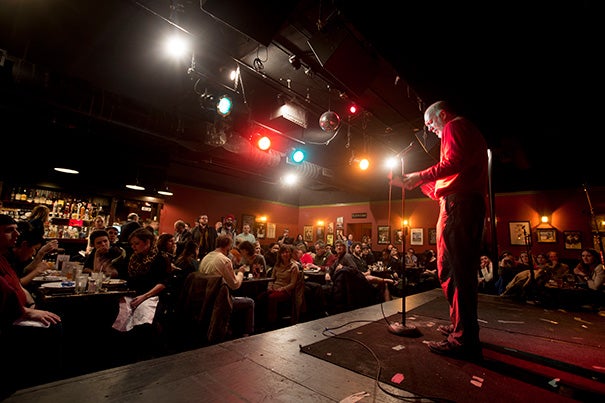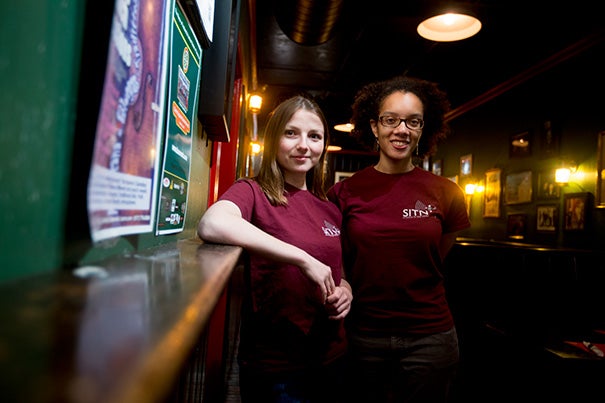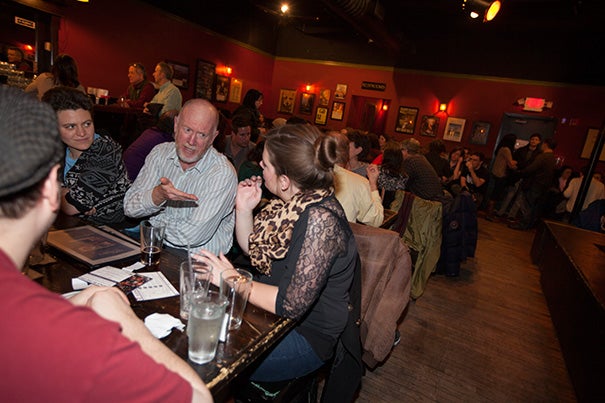
David Haig, the George Putnam Professor of Organismic and Evolutionary Biology, discussed the science behind mammals’ huddling for body warmth at “Science by the Pint.”
Rose Lincoln/Harvard Staff Photographer
‘Brain candy,’ with beer
Offbeat GSAS student series hosts scientific talks in a pub’s backroom
Science left the lab Monday night and found a warm welcome — along with some frothy pints — in the backroom at The Burren, an Irish pub in Somerville.
David Haig, the George Putnam Professor of Organismic and Evolutionary Biology, took the stage for the graduate student-sponsored outreach program, sharing the science of body heat on a not-so-cold winter night.
“I love it. This is awesome,” said John Chamberlain, a Medford native who joined other science enthusiasts to hear Haig’s presentation. “You get to talk to scientists, pick their brains. It gets your own mind thinking about this stuff. If you’re a nerd like us, it’s brain candy … and there’s beer.”
Haig spent about 20 minutes discussing the science behind the practice by warm-blooded mammals and birds of huddling together to maintain heat. He took the audience on a globe-spanning tour, from the bare Antarctic ice, where emperor penguins huddle for months as they incubate eggs; to a rat’s den, where nearly naked rat pups snuggle for warmth; to a winter burrow, where marmots pile to keep their bodies from freezing; to hospital delivery rooms, where humans are born.
“It sounded like a fun thing to do, talking in a very different environment,” Haig said of the offbeat venue. “It’s a little bit of a challenge to be educational … It’s hard sometimes just to talk to members of your department about what you’re doing. Tonight, to talk to people with … less background — in ways that are not misleading — is a bigger challenge.”
The Science by the Pint series is run by students from Harvard’s Graduate School of Arts and Sciences. The program, one of several run by the GSAS student group Science in the News, is coordinated by doctoral students Nicole Espy and Cristina Popa.
Science by the Pint began in 2008 and each month features a different Harvard scientist in an informal discussion of science and of research. In recent months, the program has been drawing 60 to 70 people to its events, Espy said, though Monday’s crowd was between 80 and 100.


Image 1: Students Cristina Popa (left) and Nicole Espy organized tonight’s “Science by the Pint” held at The Burren in Davis Square. Image 2: Haig spoke with patrons after his presentation.
Rose Lincoln/Harvard Staff Photographer
The program kicks off with the scientist’s talk and then segues into a more informal segment, where the scientist, graduate students, and postdoctoral fellows rotate among tables to answer questions and talk about their work.
“We’re trying to put a scientist at every table so everyone gets a chance to meet” them, Popa said.
Popa and Espy said the program’s goal is to make science more approachable and discuss interesting issues that members of the community read about regularly. Past topics have included bioethics, yeast evolution, and the troubles facing honeybees.
“We’re trying to put a face to the scientists, and we invite the community to demonstrate how scientists, I guess, walk among us,” Espy said, so “science doesn’t seem locked in a bubble.”
Ann Fiegen, a graduate student and past treasurer of Science in the News who attended Monday’s event, said the program discourages lengthy, formal, PowerPoint-fueled presentations and instead asks the scientists to deliver short talks that kick off the subsequent discussion. Besides informing the community, the program benefits graduate students and postdocs who participate in the table talks, Fiegen said, giving them practice in discussing complex scientific subjects — including their own work — in a way that is easily understandable.
Haig’s talk ranged from snuggling practices to nudity, which branched off to why some creatures are born hairy or feathered and fully formed — like horses, cows, and chickens — while others are born naked — like humans, robins, and rats — and so require extra care and development. Haig said he suspects the difference depends on how the newborn stays warm. If it is independent and needs to conserve its own heat, it is born furred or feathered. If it takes heat from its mother and its nest- or littermates, it is born naked.
The Burren’s Dan Moy said the series is an offbeat selection among the wide array of events at the pub, which include music, poetry, and standup comedy.
“We are a really diverse place. We like to do different things,” Moy said. “This is the biggest one [so far]. Every month it’s been bigger.”




